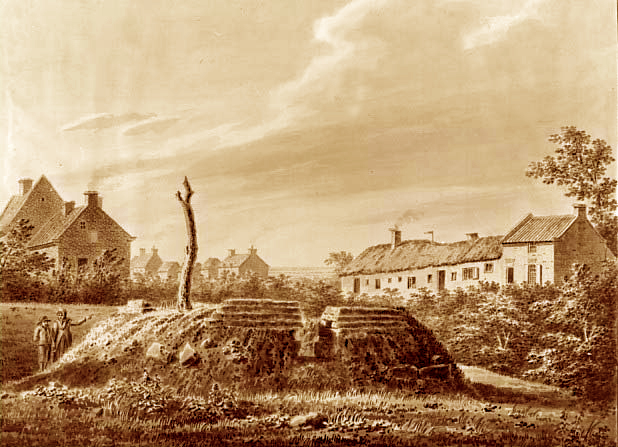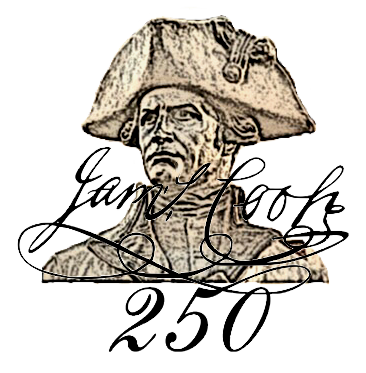
Marton (1728-1736)
MARTON, a village and a parish in Stokesley district, N. R. Yorkshire. A spot called Cook’s Garth was the site of the birth-place of the circumnavigator Cook, a two-roomed mud cabin, destroyed by a Major Rudd; and on a height in the neighbouring township of Easy, stands a mounment to Cook, an obelisk 51 feet high, erected in 1827. [A Vision of Britain through Time]Soon after news of Cook’s death reached England the site of the birthplace cottage at Marton, Middlesbrough, became one of the most important mementoes of Cook’s life.
Soon after news of Cook’s death reached England the site of the birthplace cottage at Marton, Middlesbrough, became one of the most important mementoes of Cook’s life.
Although the building itself was flimsy and quickly fell into disrepair after abandonment by the last occupants local people kept its significance and Cook’s memory alive by marking its location.The remains of the cottage’s clay walls and earth platform were levelled by the Rudd family, the new owners of the estate, as part of their redevelopment of East Marton village. The village and the site of the cottage were recorded by the artist George
The remains of the cottage’s clay walls and earth platform were levelled by the Rudd family, the new owners of the estate, as part of their redevelopment of East Marton village. The village and the site of the cottage were recorded by the artist George Cuit (1743-1818) in about 1788.
Bartholomew Rudd purchased the Marton estate in 1786 and cleared East Marton village to make way for his new house, Marton Lodge, and its grounds. This involved removing the remains of Cook’s birthplace but Rudd seems to have realised the historical importance of the cottage and marked out its original site by a quadrangle of flint stones in the courtyard of the stable block of his new home.
Marton Lodge burned down in 1832 and the estate was neglected until it was purchased by one of Middlesbrough’s leading industrialists, Henry Bolckow, in 1853. Bolckow removed the remains of the buildings and yards associated with the Lodge, including the cobbles marking the site of Cook’s birthplace and built a grand new mansion called Marton Hall. This Hall survived until 1960 when it too was destroyed by fire and demolished.Bolckow replaced the cobbles marking the site of Cook’s birthplace cottage with a commemorative granite urn with the legend: “This Granite Vase was erected by H.W.F.Bolckow of Marton Hall, A.D.1858, to mark the site of the cottage in which Captain James Cook, the World Circumnavigator was born, 27th
Bolckow replaced the cobbles marking the site of Cook’s birthplace cottage with a commemorative granite urn with the legend: “This Granite Vase was erected by H.W.F.Bolckow of Marton Hall, A.D.1858, to mark the site of the cottage in which Captain James Cook, the World Circumnavigator was born, 27th October, 1728”
Bolckow replaced the cobbles marking the site of Cook’s birthplace cottage with a commemorative granite urn with the legend: “This Granite Vase was erected by H.W.F.Bolckow of Marton Hall, A.D.1858, to mark the site of the cottage in which Captain James Cook, the World Circumnavigator was born, 27th October, 1728”
Bolckow developed his interest in Cook, collecting Cook memorabilia, journals, letters and personalia which he displayed as part of his art and historic collections in Marton Hall. An 1870s inventory of household contents lists: ‘Mr.C.F.H. Bolckow Room. “Captain Cook” by Webb’
Bolckow sold his collection of Cook material at Sotheby’s in 1923 and this portrait is now in the collection of the National Art Gallery, Wellington, New Zealand. At a meeting in May 1928 representatives from the Councils of Middlesbrough, Redcar and Whitby, Rotarians from Middlesbrough and Saltburn, the Territorials and the village of Marske, decided to stage celebrations to mark the 200th anniversary of Cook’s birth.
At a meeting in May 1928 representatives from the Councils of Middlesbrough, Redcar and Whitby, Rotarians from Middlesbrough and Saltburn, the Territorials and the village of Marske, decided to stage celebrations to mark the 200th anniversary of Cook’s birth.
A souvenir booklet was produced which gave details of all the permanent memorials to Cook in the North East area along with a programme of “Celebrations planned for Whitby, Redcar, and other places in Cleveland connected with Captain Cook’s lifetime.” These included the ‘Pilgrimage’ at Marton on 8th September 1928 and a line of beacons “…to be lighted on the Cleveland Hills from Whitby to Ayton on October 27th, the actual anniversary of his birthday…”
The Captain Cook Celebrations still take place annually around the time of Cook’s birth (27th October).
The register of St. Cuthbert’s Parish Church, Marton, Middlesbrough, contains the first historical reference to James Cook. Named after his father the entry reads: “Nobr. (November) 3 James ye son of James Cook day labourer baptized.”
The annual Service of Thanksgiving for Cook’s life still takes place here on the Sunday nearest Cook’s birthday.
This memorial window with a depiction of Captain Cook was installed in St. Cuthbert’s Parish Church, Marton, in 1951. Its dedication reads: “ In loving memory of/Henry W.F. Bolckow 1865-1947, Bessy M.Bolckow 1867-1944/H.Cuthbert R. Bolckow 1897-1944/This window was given by Dorothy M.Bolckow.”
The Captain Cook Birthplace Museum was opened by Middlesbrough Council in a purpose-built building in 1978 to mark the 250th anniversary of Cook’s birth. The displays tell the story of Cook’s life and achievements and are supported by a lively programme of educational activities, temporary exhibitions and special events.
The building stands on the site of Marton Lodge and Hall and within yards of the granite urn which has traditionally marked the location of Cook’s birthplace cottage.
As part of the Captain Cook Celebrations ’03 which marked the 275th anniversary of Cook’s birth, the Australian-built replica of Cook’s ship on the first voyage, HM Bark Endeavour, visited Middlesbrough for the first time. Moored in Middlehaven, the site of the former Middlesbrough Dock, Endeavour attracted over 22,000 people to the site, more than half of these visitors actually went aboard. A full programme of special activities and events were organized to coincide with the visit.
